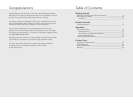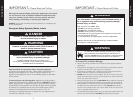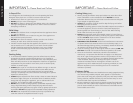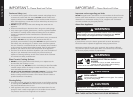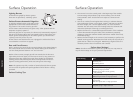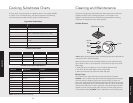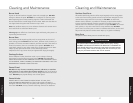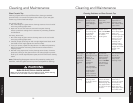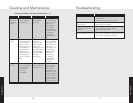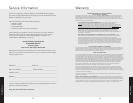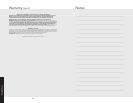
7
Getting Started
6
Getting Started
In Case of Fire
Turn off appliance and ventilating hood to avoid spreading the flame.
Extinguish flame, then turn on hood to remove smoke and odor.
• Smother fire or flame in a pan with a lid or cookie sheet.
• NEVER pick up or move a flaming pan.
• DO NOT use water on grease fires. Use baking soda, a dry chemical or
foam-type extinguisher to extinguish fire or flame. Let fat cool before
attempting to handle it.
Child Safety
• NEVER leave children alone or unsupervised near the appliance when it
is in use or is still hot.
• NEVER allow children to sit or stand on any part of the appliance as
they could be injured or burned.
• DO NOT store items of interest to children over the unit. Children
climbing to reach items could be seriously injured.
• Children must be taught that the appliance and utensils in it can be hot.
Let hot utensils cool in a safe place, out of reach of small children.
Children should be taught that an appliance is not a toy. Children
should not be allowed to play with controls of other parts of the
appliance.
Cooking Safety
• To eliminate the hazard of reaching over hot surface burners, cabinet
storage should not be provided directly above a unit. If storage is
provided, it should be limited to items which are used infrequently and
which are safely stored in an area subjected to heat from an appliance.
Temperatures may be unsafe for some items, such as volatile liquids,
cleaners or aerosol sprays.
• ALWAYS place a pan on a surface burner before turning it on. Be sure
you know which knob controls which surface burner. Make sure the
correct burner is turned on and that the burner has ignited. When
cooking is completed, turn burner off before removing pan to prevent
exposure to burner flame.
• ALWAYS adjust surface burner flame so that it does not extend beyond
the bottom edge of the pan. An excessive flame is hazardous, wastes
energy and may damage the appliance, pan or cabinets above the
appliance. This is based on safety considerations.
• NEVER leave a surface cooking operation unattended especially when
using a high heat setting or when deep fat frying. Boilovers cause
smoking and greasy spillovers may ignite. Clean up greasy spills as soon
as possible. DO NOT use high heat for extended cooking operations.
• DO NOT heat unopened food containers, build up of pressure may
cause the container to explode and result in injury.
IMPORTANT–
Please Read and Follow
IMPORTANT–
Please Read and Follow
Cooking Safety (cont.)
• Use dry, sturdy pot-holders. Damp pot-holders may cause burns from
steam. Dishtowels or other substitutes should NEVER be used as
potholders because they can trail across hot surface burners and ignite
or get caught on appliance parts.
• ALWAYS let quantities of hot fat used for deep fat frying cool before
attempting to move or handle.
• DO NOT let cooking grease or other flammable materials accumulate in
or near the appliance, hood or vent fan. Clean hood frequently to
prevent grease from accumulating on hood or filter. When flaming
foods under the hood, turn the fan off.
• NEVER wear garments made of flammable material or loose fitting or
long-sleeved apparel while cooking. Clothing may ignite or catch utensil
handles. DO NOT drape towels or materials on oven door handles.
These items could ignite and cause burns.
• PREPARED FOOD WARNING: Follow food manufacturer's instructions.
If a plastic frozen food container and/or its cover distorts, warps, or is
otherwise damaged during cooking, immediately discard the food and
its container. The food could be contaminated.
• If you are “flaming” liquor or other spirits under an exhaust, TURN THE
FAN OFF. The draft could cause the flames to spread out of control.
• Once the unit has been installed as outlined in the Installation
Instructions, it is important that the fresh air supply is not obstructed.
The use of a gas cooking appliance results in the production of heat
and moisture in the room in which it is installed. Ensure that the kitchen
is well-ventilated. Keep natural venting holes open or install a
mechanical ventilation device. Prolonged or intensive use of the
appliance may call for additional (such as opening a window) or more
effective ventilation (such as increasing the level of a mechanical
ventilation if present).
Cookware Safety
• Use pans with flat bottoms and handles that are easily grasped and stay
cool. Avoid using unstable, warped, easily tipped or loose-handled
pans. Also avoid using pans, especially small pans, with heavy handles
as they could be unstable and easily tip. Pans that are heavy to move
when filled with food may also be hazardous.
• Be sure cookware is large enough to properly contain food and avoid
boilovers. Pan size is particularly important in deep fat frying. Be sure
pan will accommodate the volume of food that is to be added as well
as the bubble action of fat.




